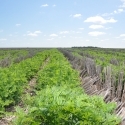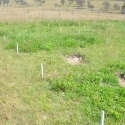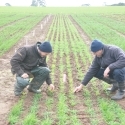Potassium removal and use in Australia
 Muriate of Potash at the outloading sheds in Vancouver
Muriate of Potash at the outloading sheds in Vancouver
Since 2002, K use in Australia has remained essentially static at around 180 kt/y with a range between 130 kt (2008/09) to 215 kt (2015/16). Over the past two decades, the use of P has declined by around 10% while N use has increased by 50%, so that Australian growers are using relatively more N and relatively less K. The industries that use the most K are the grains and cotton industries (37%) and the dairy industry (30%), with horticulture ((17%) and sugar (14%) comprising the other major segments. The grains industry produces around 40 Mt annually with the main crops being wheat, barley and canola.
Much of Australian agriculture is extensive and yields are relatively modest as most production is rainfed. Based on agricultural production figures and fertilizer use data, but excluding recycled materials and manures, Australia has a negative K balance of around nearly 400 kt per year, which is a removal to use ratio (Partial Nutrient Balance, PNB) of 3.2 across all agricultural areas. All states, except Tasmania, shown K removals more than K application, and there is significant variation from year to year in these values due to changing production in response to seasonal conditions. There are large differences among industries, with cotton showing positive balances (+9 kg K/ha/y) but most of the extensive cropping industries with negative balances (– 4 kg K/ha/y), and this pattern of removal> use has been consistent over the past 20 years. The sugar industry shows the largest apparent deficit, but the values estimated do not include recycled mill wastes.
To investigate the distribution of nutrient performance indicators among growers, a survey of 514 grain production fields over 3-5 years in south-eastern Australia was undertaken. Annual K balances were estimated from the input of fertilizer K and the removal of products. This region in particular is undergoing increased cropping intensity and the high rainfall zones in particular have high yield potentials and has promise for future expansion of the grains industry. K nutrient performance indicators were estimated for the period 2010-2014 from these survey data. Even though 15% of soil test K levels are less that the critical value, only 9% of crops received a mean K application rate of 75 kg K/ha while K removal ranged up to 250 kg K/ha/y. In only 6 fields survey there was a K-PNB<1. but 6 fields K balance was negative. Where K was applied, partial factor productivity values were in the range of 150-300 kg grain/kg K applied. Given these factors of increased production, low K application, high removals, and marginal soil K levels, growers will need to pay increasing attention to K management in particular.
A copy of the paper and presentation can be downloaded from here.
Additional Resources
Copy of Paper from Frontiers of Potassium, 2017Size: 0.67 MB
Copy of presentation from Frontiers of Potassium, 2017Size: 1.48 MB




